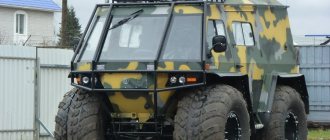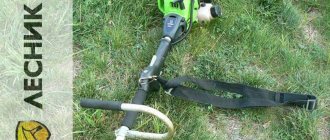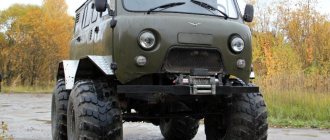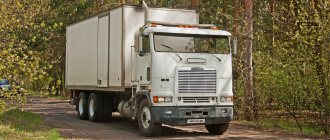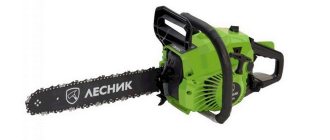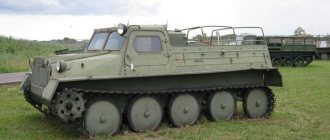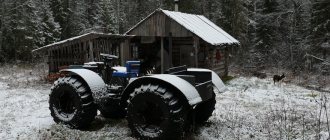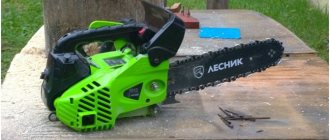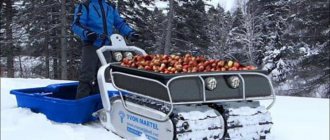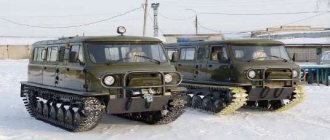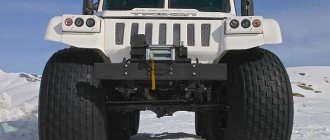The Lesnik snow and swamp-going vehicle differs from other all-terrain vehicles in its large number of passenger seats, up to eight people, and its high carrying capacity. The basic cost of this all-terrain vehicle includes the function of centralized pumping.
The amphibious all-terrain vehicle "Lesnik" is a floating snow and swamp-going vehicle that was created. The machine uses low pressure pneumatic wheels. Previously, it was produced in 3 main types: “Lesnik”, “Lesnik-M”, “Lesnik-M Sever”. Now additional varieties have appeared.
All-terrain vehicle extreme
The equipment was intended for transporting goods and passengers along roads with soft soil, through swampy areas, and for passing water obstacles. The new Lesnik Extreme 2022 has good driving characteristics. He is able to independently move out of the river onto the ice without a winch. The tent top and comfortable interior allow you to organize an overnight stay, and a good stove will keep you warm in cold weather.
The all-terrain vehicle has the following characteristics:
- length - 435 cm;
- width - 254 cm;
- height - 270 cm;
- curb weight - 1750 kg;
- ground clearance - 65 cm;
- number of places - 7;
- fuel consumption - 15-30 l/100 km depending on operating conditions;
- load capacity on hard soils - 500 kg;
- load capacity on water and weak soil - 300 kg.
Assembly instructions
According to the drawings, the frame is welded from a steel profile. The metal needs to be chosen stronger, because... The equipment is designed for off-road driving and swampy terrain. Then the frame is sheathed with sheets of duralumin material.
Rubber pads are used to secure the transmission and transfer case to the frame to eliminate noise and vibration. Bridges are attached to the structure with bolts and nuts; welding is not recommended.
The engine is installed in the middle of the frame on rubber mounts, then the cooling radiator and all the necessary pipes are fixed. The fuel tank is attached to the frame, from which the fuel line goes to the mechanical fuel pump. Afterwards the electrical equipment and fuse box are installed.
VAZ hubs are installed on the frame, and springs are attached to the rear.
To install wheels on Zhiguli wheels, an additional rim is welded on and checked for the absence of runout. This design allows you to use tires of the desired size.
When making all-terrain vehicles with their own hands, they use the power unit and gearbox from a domestic VAZ car, axles and driveshafts from a UAZ car.
Chassis
One of the developers’ goals was to assemble the simplest possible structure, where there would literally be nothing to break, and the necessary repairs could be carried out in the field. Many chassis and suspension elements were taken from other domestic cars. For example, the axles and driveshafts are taken from the UAZ-469, the gearbox and steering wheel are from the VAZ-21083. The engine is taken from a VAZ-21114, the radiator of the cooling system is from a Chevrolet Niva. This made it possible to reduce the cost of the car, simplify its operation and repair, and at the same time eliminated all possible problems with the availability of spare parts. Parts for VAZ and Niva can be found in any city or town where there is an auto shop.
The front axle is without a gearbox and is rigidly attached to the body, that is, there is no front suspension. There is also no transfer case or additional drives, which makes it possible to reduce the weight of the all-terrain vehicle and reduce the likelihood of breakdowns. Also in the front part there is protection for the steering mechanism, a socket for attaching an electric winch and a socket for connecting it.
Be sure to read: Technical characteristics of the Vityaz DT-30 swamp vehicle
The rear suspension is spring. The rear axle is also without a gearbox. The center differential is locked to improve cross-country ability. Also in the rear part there is a place for mounting a boat motor (hydraulic propeller).
The use of low-pressure tubeless wheels ensured high maneuverability, excellent shock absorption when driving over rough terrain and buoyancy when crossing water obstacles. Buoyancy and shock absorption are provided by a large volume of air, and the ability to move unhindered on ice and snow is provided by increasing the support area and, therefore, reducing pressure on the surface. The “mud” tread pattern provides traction when driving on sand, wet clay and other soft and sticky soils.
Main features of the chassis:
- The base model does not have a front suspension, which simplifies the design and reduces the likelihood of breakdowns.
- Wheels up to 1600 mm high provide excellent visibility and the ground clearance necessary for an all-terrain vehicle.
- The use of Russian components guarantees a minimum price, as well as the availability of spare parts and qualified repairs.
- The opportunity to purchase a model with full suspension and imported parts expands the range of buyers.
Forester light
The cabin of the all-terrain vehicle is made of solid material - fiberglass. The cabin is well insulated and suitable for winter overnight stays at sub-zero temperatures.
The snow and swamp-going vehicle has the following technical characteristics:
- length - 370 cm;
- width - 232 cm;
- height - 240 cm;
- curb weight - 850 kg;
- ground clearance - 48 cm;
- load capacity - 500 kg;
- load capacity on loose soil and bogs - 300 kg;
- maximum speed 50 km/h;
- number of places - 7.
The Lesnik Light all-terrain vehicle is equipped with a gasoline, carburetor power unit from the VAZ-2106 - 1.6 liters, 80 hp, with a torque of 125 Nm. Works with a 5-speed manual transmission.
Homemade cars
Vadim Kornienko from Rostov-on-Don, converted his old Niva into a floating amphibious all-terrain vehicle.
By chance, we managed to buy a 1984 Niva car cheaply. True, the body was in a very depressing state, the wings were rotten, the floor was full of holes, and besides, one of the bridges was torn off, but technically everything more or less worked.
For this homemade car, the owner of an SUV, for the project to create a floating amphibian, he was inspired by the Soviet developments of the “waterfowl VAZ-2121”; such cars were created, but remained produced in single copies.
The main work was to “reanimate” the body, and since there was no living space left on the car, I had to do a lot of work with an angle grinder. There was no goal to make a car for a “museum”, so all the transformations were purely practical. The transfer case compartment and gearbox were made insulated, using metal 2 mm thick.
Important Wheeled and tracked excavators Hyundai
The front, rear and side floats were made from a 1 mm sheet. I wanted the car not to be very different from a regular Niva, so I made the bumpers not very protruding. The front one is about 70 liters, the rear one is a little more. In Niva amphibians 2122, the tightness of the doors is ensured by sealing rubber bands. But over time, the elastic bands dry out and will leak. Therefore, it was decided to shorten the doors a little and make side floats. According to my calculations, the water should not reach the lower edge of the doors. Looking ahead, I will say that this is what happened and I was not mistaken in my calculations.
Here we had to tinker. The threshold is cut off and moved upward by 30 cm. The wing arches are cut to accommodate 31st wheels.
Since the engine and radiator are in a confined space, so that the engine does not overheat, I decided to move the radiator outside. The engine will cool better. I'll cover the radiator with a decorative grille and install a fan. In place of the radiator there is a muffler resonator, and the muffler is under the hood and the pipe is routed along the side edge of the windshield. The muffler legs and the resonator will be connected through a corrugation. The generator goes up by itself (I’m already making the brackets with my eyes closed).
To prevent the transfer case and gearbox from flooding with water, we had to make a sealed box from sheet metal. The transfer case and transfer case are in a closed volume, therefore they will heat up. On Niva 2122 this was a big problem. In general, I did cooling with flowing air. I had to turn the heater radiator over. In its place is an air duct box. Well, I installed a fan. All that remains is to fold the plastic boxes and the air will escape overboard.
An auger was used as the main propulsion device, which was welded to a cardan, so the Niva on the water is driven by both wheels and an improvised auger.
A 12V water pump (50 l/min) is installed in the pan, and the hose is routed to the left wing. I checked it, it pumps well. It will be calmer on the water.
The end result was as follows: “Niva” both floats and moves on land. On the water in 4th gear without downshifting at 1600 rpm, the navigator showed 4.6 km/h. It even swims against the current (albeit in windless weather). Which is pretty good.
Video: “Niva” floats down the river.
Homemade author: Vadim Kornienko. Rostov-on-Don.
Share on social media networks
Popular homemade products on our website
- DIY all-terrain vehicle from Oka
- Crawler UAZ "Ukhtysh" floating snow and swamp vehicle
- DIY buggy all-terrain vehicle
- DIY tracked all-terrain vehicle: photo, video
- Homemade all-terrain vehicle "Green Monster"
- Homemade all-terrain vehicle on low-pressure tires from...
- Homemade all-terrain vehicle from Oka
- Homemade tracked all-terrain vehicle
- Homemade all-terrain vehicle from GAZ-24
- Three-wheeled all-terrain vehicle with low pressure tires
- All-terrain vehicle on low-pressure tires: (37 photos)
- Homemade carakat all-terrain vehicle from a motorcycle
- DIY all-terrain vehicle made from a walk-behind tractor
- Homemade all-terrain vehicle with a VAZ-2108 engine
Required parts and tools
To make an all-terrain vehicle, you must have the following tools and materials:
- engine with exhaust system and attachment;
- axles with differentials;
- Gearbox and transfer case;
- cardan shafts;
- engine cooling radiator;
- steering;
- tires;
- metal pipe;
- a set of locksmith tools;
- drill;
- welding machine.
During the work process, you may need easily accessible tools and small consumables.
General design features
Lesnik-M, unlike Lesnik, has a glass half-cabin, a protective compartment for the engine and a stove. The details of the body configuration differ slightly.
Lesnik M-Server differs from Lesnik-M by a body made of duralumin metal, with interior ventilation and a completely insulated engine compartment. The design of the transmission, as well as the material for the production of body parts, are the same in all trim levels.
The most expensive and important part of an all-terrain vehicle is the special ultra-low pressure wheels.
The tires on them come in different types; they are selected individually depending on where the equipment will be used.
The snowmobile body is made of a profile pipe, covered with aluminum sheets, painted with special anti-corrosion paints. The engine and gearbox are installed in the middle of the frame, which allows the swamp vehicle to maintain its center of gravity when overcoming water obstacles.
Prices and additional equipment
| Name of additional equipment | Price |
| Tires 1600x700x25″, 1650x570x25″ 1650x650x25″ | |
| Hydrostatic steering | goes to the database |
| Folding windshield | goes to the database |
| Power protection for the front of the all-terrain vehicle | goes to the database |
| Central tire inflation system | goes to the database |
| Protective coating of the all-terrain vehicle frame against corrosion | goes to the database |
| Front winch permanently installed Come.Up Cub 6 | RUB 115,000.00 |
| Body color optional, to choose from the RAL catalog | RUB 38,500.00 |
| Combined body color (green, black, gray) - corporate camouflage | RUB 56,000.00 |
| Engine preheater, Webasto or Eberschpreher, 5KW. | RUB 90,000.00 |
| Autonomous interior heater, Webasto or Eberschpreher, 4KW. | RUB 113,000.00 |
| Two batteries with operating mode switch (diesel versions only) | RUB 31,800.00 |
| Removable tow hitch in a square ball shape | RUB 4,600.00 |
| Removable tow hitch in a square ring with a connected socket for attaching a Trekol-8901 trailer | RUB 19,200.00 |
| Removable slats for organizing sleeping places with soft pillows (transformable into slats for bedding) | RUR 33,600.00** |
| Sunroof above the driver's seat 600x800 | RUB 28,800.00 |
| Sunroof over cargo compartment 600x800 | RUB 28,800.00 |
| Fastening for installing a radio station (wiring, threaded nuts for the bracket, reinforcement in the roof for the antenna) | RUB 9,000.00 |
| Mounting for installation of a radio (console for the radio, housings for speakers, wiring) | RUR 22,000.00 |
| Expeditionary roof rack | RUB 32,000.00 |
| LED roof light, mounted on a bracket, length 30″ (single-row chandelier), combination light, 100W. | RUB 34,000.00 |
| Searchlight searchlight with remote control (remote control), LED 30 W. | RUB 56,000.00 |
| Side handrails on the sides of the all-terrain vehicle | RUB 18,000.00 |
| Internal body partition with window | RUB 54,000.00 |
| Passenger version of the cargo part of the all-terrain vehicle. (additional two windows, six seats with seat belts and handrails) | RUB 120,000.00 |
| LED headlight above the rear door, 2″, panoramic light, 40W. | RUB 23,500.00 |
| Rear view camera with monitor | RUB 19,000.00 |
| Additional sliding windows at the rear of the all-terrain vehicle | RUB 20,000.00 |
| Front wheel rims with fuel tank (diesel only) | 64,000.00 rub. |
| Spare wheel: “Lesnik” rim, TRECOL tire 1600x700x635 | RUB 111,900.00 |
| Spare wheel: rim “Lesnik”, tire “Trom-16″ 1650x570x25” | RUB 108,800.00 |
| Spare wheel: “Lesnik” rim, “Rusak” tire 1650x650x25″ | RUB 122,200.00 |
| Protective cap for HDPE wheel 3mm 25″ | RUB 12,800.00 |
| Wheel rim “Lesnik 1600” | RUR 25,600.00 |
| Floor carpets made of EVA material | RUB 10,500.00 |
*available when ordering a rigid fiberglass body
**available if the passenger version of the cargo part of the all-terrain vehicle is not available
General rules of use
When driving an all-terrain vehicle, you need to understand that the vehicle is designed for off-road and swampy terrain, so you should not accelerate on asphalt, because the car may lose control. Before leaving, be sure to check the pressure in the tires, clutch and brake pedals.
Periodically you need to check the fastenings of all components and mechanisms that may become loose over time. It is recommended to drive with a full fuel tank, because... The car's consumption is high, so that somewhere in the wilderness you won't be left without fuel.
It is not recommended to overload the machine: you cannot carry more than the specified load capacity.
The number of passengers must correspond to the equipped seats. It is strictly forbidden to drive an all-terrain vehicle while intoxicated.
Also interesting: What is a video wall and how is it used in business?
New models for the most challenging tasks
After the successful launch of a project called “Lesnik”, the developer decided not to stop there and created new products that found their buyer. For example, an all-terrain vehicle was released with the addition of the letter M, which has some differences.
They may seem insignificant to an inexperienced person. But connoisseurs immediately saw the merits of the new products. For example, the Lesnik-M all-terrain vehicle has a glass half-cabin. It also differs in that the engine compartment is isolated. The engineers also worked on pleasant little things that make traveling over any distance and in different conditions more enjoyable and safer. So, they improved the interior decoration, added a running awning to the package, and also offered an excellent interior heater. One can easily imagine that such a model is more advantageous when it comes to using transport in harsh winter conditions.
“Lesnik-M” is also equipped with a front glass with a wiper, and there is lighting inside the cabin. The engineers decided to install disc brakes on the front axle.
Apparently, the chosen direction turned out to be correct. Because the engineers continued to move in it. The next product was the Lesnik-M Sever all-terrain vehicle. He is even more different from his brothers. For example, its body is made of all-metal duralumin. Windows and doors open in transport. I am very pleased with the fact that there is full ventilation inside the cabin, as well as improved insulation of the engine compartment.
It is worth noting that the key components of the design are identical in all three models. So you can experience the pleasure of driving in off-road conditions bordering on extreme sports by mastering the “Forester”. To get behind the wheel of such an all-terrain vehicle, you must obtain a license that gives you the right to drive a tractor.
Snow and swamp-going vehicle "forester-m north".
March 2022
The TREKOL company produces a whole family of all-terrain vehicles. It also has an all-terrain vehicle LESNIK-M NORTH. (The all-terrain vehicle was developed at LLC "LESNIK" in Vologda, but distribution in Russia is handled by TREKOL.) The all-terrain vehicle was demonstrated at the exhibition Hunting, Fishing 2020
The all-terrain vehicle "LESNIK-M" is a wheeled all-terrain vehicle with ultra-low pressure tires. It is designed for use on weak-bearing soils, as well as for overcoming water obstacles.
The body of the snow and swamp-going vehicle is made on the basis of a frame made of metal pipes and covered with duralumin sheets. Sheathing sheets are fixed to the frame using rivets.
The body of the all-terrain vehicle has two side windows. There is also a window on the back door. All windows are sliding. The windshields are triplex, they are glued into the window openings.
The all-terrain vehicle has a reinforced roof that protects the driver and passengers when the all-terrain vehicle turns over. The body is painted with RAPTOR protective compound
The off-road performance of an all-terrain vehicle can be improved by using an electric winch. In transport position it is fixed to the body. If necessary, the winch is inserted into the fastening mechanism (square), which is located in front and behind the all-terrain vehicle, connected to an outlet and can be used.
The body is insulated from the inside with 20mm thick penoplex and covered with carpet-type fabric
The driver's position is a little unusual - in the middle of the all-terrain vehicle (like a Viking all-terrain vehicle). Panoramic windows provide good visibility.
The motor is located longitudinally, behind the driver's seat, actually in the middle of the all-terrain vehicle. The engine can be supplied either with a petrol VAZ-21114 or a diesel KUBOTA - V1505
If you need to spend the night, you can arrange a sleeping place right in the cabin. There are three slings attached to the ceiling. They are placed between the seats and you get a flat area measuring 1800x2000.
You can hang a boat motor on the stern. For this purpose, the side of the all-terrain vehicle has special reinforcement.
The rear suspension is leaf spring. UAZ bridges, without the use of final drives.
Disc brakes. An all-terrain vehicle is usually equipped with centralized wheel inflation.
Tubeless tires, ultra-low pressure TREKOL – 1300x600x533
There is no front suspension on the all-terrain vehicle. The bridge is rigidly fixed to the body.
On the right side, behind the mesh, there is a gas tank.
| Specifications | |
| Model | TREKOL-Lesnik-M |
| Wheel formula of the all-terrain vehicle | 4x4 |
| Curb weight, kg | 1350 |
| Load capacity on dense soils, kg | 500 |
| Load capacity on weak soils and afloat, kg | 300 |
| Overall length / width / height, mm | 3700/2300/2600 |
| Track, mm | 1800 |
| Ground clearance, mm | 490 |
| Fuel tank capacity, l | 40 |
| Transmission | Fur. 5-speed (VAZ-21083) |
| Steering | UAZ worm gearbox (without hydraulic booster) |
| Body | Load-bearing, frame-panel, tented |
| Number of seats | 3-5 |
| Number of heaters in the body | 1 |
| Tires | TRECOL –1300x600x533, tubeless, ultra-low pressure |
| Operating pressure range in the tire, kPa (kg/cm2) | 10…50 (0,1…0,5) |
| Maximum highway speed km/h | 50 |
| Minimum speed km/h | 2 |
| Bridges | UAZ, without wheel gearboxes |
| Brake system | Hydraulic, with vacuum booster, disc brakes |
| Suspension | Rear - spring, front - absent |
| Turning radius along outer dimensions, m | 6 |
| Fuel consumption, l/100 km | 15-30 (depending on traffic conditions) |
Also interesting: Homemade all-terrain vehicles on low-pressure tires: how to make them yourself, from a new one according to drawings.
The all-terrain vehicle is certified as a tractor. To operate it, category A2 license is required.
See also: All-terrain vehicle from the company vektor4x4 (fourth) All-terrain vehicle from the company vektor4x4 (second) TREKOL-39294 Snow and swamp-going vehicle TREKOL TROPHY Catalog of all-terrain vehicles TREKOL
up
Operating rules
The basic rule for operating a Forester is to follow the recommended tire pressure, reduce it when entering rough terrain and increase it when driving on hard surfaces. The all-terrain vehicle is equipped with Trekol tubeless tires measuring 1300 or 1600 mm. Internal pressure should not exceed 0.6 kgf/cm2 when driving on asphalt and concrete roads, 0.45 kgf/cm2 when driving on dirt roads and 0.25 kgf/cm2 on sand or virgin snow. When driving through swampy areas, it is recommended to reduce the pressure to 0.06 kgf/cm2. Failure to comply with these rules will worsen the cross-country ability, cause vibrations in the cabin, and also lead to damage to the tire. The pressure is regulated by a centralized tire inflation system controlled from the passenger compartment.
Cabin of the Lesnik all-terrain vehicle
Load capacity must also be observed. If on dense soils and hard surfaces the Forester can “carry” up to 500 kg, then when moving on soft soils and afloat it cannot be loaded with more than 300 kg.
Technical specifications of the snow and swamp all-terrain vehicle "forester-cruise" diesel engine, manufactured in 2022.
| Air pressure in tires depending on driving conditions: | |
| During long-term storage and transportation of an all-terrain vehicle | 0.3 bar |
| On smooth, hard surfaced roads | 0.25 bar |
| On dense soils, broken dirt roads | 0.2 bar |
| On weak soils, when overcoming water obstacles | 0.15 bar |
| Difficult off-road conditions, deep snow | 0.1 bar |
| Minimum pressure used for short periods of time if necessary | 0.02 bar |
Purchasing principle
To order an all-terrain vehicle on wheels, you should call, fill out a request for a call back, or write an email. Specialists will discuss all the features with the client, then offer the best method of payment, and then delivery.
It is possible to sell all-terrain vehicles for hunting and fishing with subsequent delivery by suitable transport (road, water or rail). Maintenance, additional equipment, and preparation before sale are provided.
Price: 3,800,000 rub.
Prices and extras equipment
Photo and video
Read news about the new Niva
- 5 cheapest tracked all-terrain vehicles -
- Review of all-terrain vehicles on low-pressure tires: 5 domestic and foreign models
- Caracata 4x4 all-terrain vehicles from 130 thousand rubles in stock. Fracture swamp vehicles are available and can be ordered at manufacturer prices in the Master Techno catalog.
- All-terrain vehicle Trekol - price, photos, videos - advantages and disadvantages
- All-terrain vehicle on Trekol Lesnik-Profi tires
- Amphibious all-terrain vehicle Pacher
- Homemade all-terrain vehicles on low-pressure tires: how to make them yourself, from new ones according to drawings
- Homemade all-terrain vehicles on tracks and tires: do-it-yourself off-road, fresh, snowmobiles, swamp vehicles, drawings and dimensions, how to register, make a suspension, construction plans for homemade vehicles step by step
Advantages and disadvantages
The advantages of the all-terrain vehicle are:
- good cross-country ability through water, snowdrifts and swamps thanks to low-pressure tires;
- the presence of centralized wheel inflation;
- warm and spacious interior, comfortable for an overnight stay.
The disadvantages include difficult gear shifting, an uncomfortable driver's seat, a weak cooling system - you constantly have to monitor the temperature of the antifreeze.

